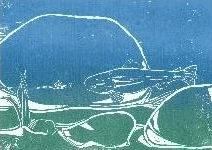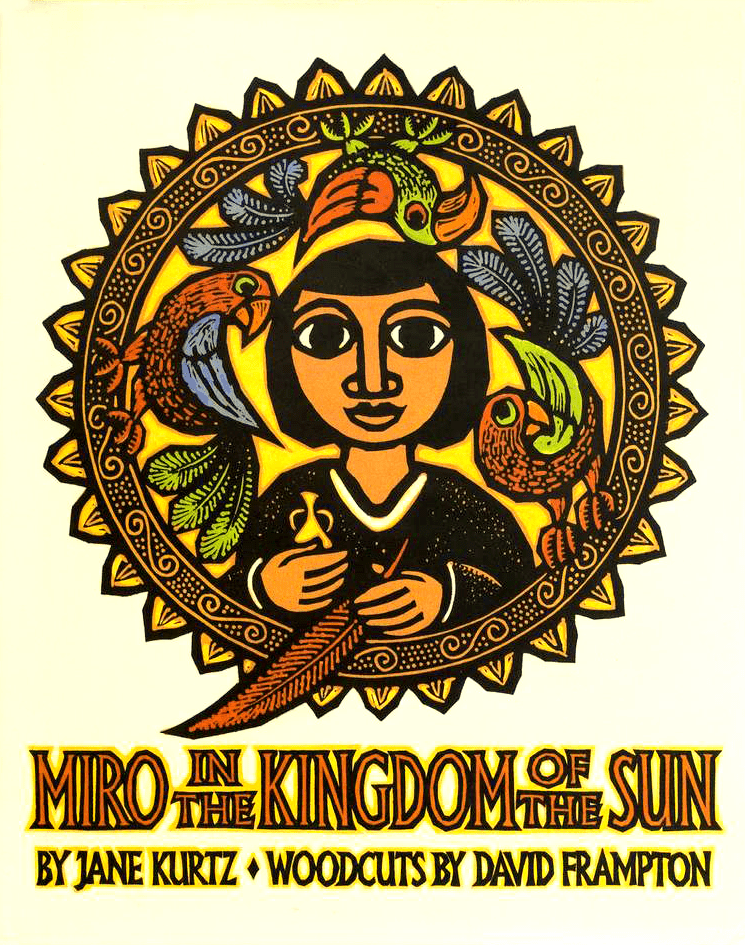Miro in the Kingdom of the Sun
Written by Jane Kurtz
Illustrated by David Frampton
Houghton Mifflin Harcourt, 1996
32 pages
Ages 5–6
ISBN: 978-0-395-69181-6
A retelling of an ancient folktale follows Miro, a young Incan girl, who struggles to find the cure for the city’s sick and dying prince, whose only hope lies in the water from a lake “at the corner of the world.”
Reviews
“A re-telling of an Inca folktale. Miro sets out on a quest to find the lake at one of the corners of the earth so she can find the magic water to save the prince and free her brothers. Frampton’s strikingly bold woodcuts, filled with color and given geometric patterns and borders, are the perfect complement to this tale, evoking the magic and mystery of a vanished ancient culture….Kurtz combines formal language and a contemporary style to make the story at once accessible and other worldly.”
“Kurtz expands on an Incan folktale, ‘The Search for the Magic Lake,’ casting it in the dignified, almost reverent prose of a high fantasy quest tale. Frampton’s tinted woodcuts, rugged and bold befitting Miro’s adventures, incorporate intricately patterned motifs from Incan art in strong and rugged earthtones.”
“Throughout, Kurtz deftly weaves in details of pre-Conquest Inca life, giving readers a glimpse of a vanished culture as well as a good story. An excellent choice for children ready to go beyond Western fairy tale favorites.”
“Kurtz is a superb storyteller….an unusual and outstanding offering.”
Classroom Resources
Reading & Writing
- Learn more about how the author researched and wrote the text and how the illustrator illustrated this book.
- Read about the Incas
- Research: How did what Pizarro found at Cuzco influence what later happened in the northern part of the American continent?
- Research the kind of effect the gold had on Spain once it got there.
- Despite the fact that the Spainards had most of the Incas’ treasures and beautiful things, the Incas did give us a most precious gift.
- Read The Amazing Potato : a Story in Which the Incas, Conquistadors, Marie Antoinette, Thomas Jefferson, Wars, Famines, Immigrants, and French Fries all Play a Part. by Melton Meltzer (HarperCollins, 1992).
- Read another good book about the Incas, Gold: The True Story of Why People Search for It, Mine It, Trade It, Steal It, Mint It, Hoard It, Shape It, Wear It, Fight and Kill for It by Milton Meltzer (HarperCollins, 1993)
- Compare this version of the folktale with “The Search for the Magic Lake” by Genevieve Barlow in Latin American Folktales (Rand McNally, 1966).
- The Incas loved storytelling, and they told stories of the beginning of the world and of the hacha hacha, the eastern jungle where they said a great dragon snake lived. You can read one of their stories, for example, in From Out of the Ark: Stories from the World’s Religions by Anita Ganeri (Harcourt, 1996).
- Research to find out how these people influenced or who were part of the early Inca civilization.
- Father Bernabe Cobo
- Pedro de Cieza de Leon
- Pedro Sancho de la Hoz
- Tomas Garcilaso de la Vega
- Compare and contrast another book illustrated by David Frampton, Whaling Days (Houghton Mifflin) to Miro in the Kingdom of the Sun
- Take a close at some of the Inca symbols in these old pictures. You can carve one of the symbols onto styrofoam and then, using ink and a roller, create your own prints to illustrate Miro in the Kingdom of the Sun.
About the Illustrations
 At the end of the 14th Century in Europe, artists began to use sharp tools to carve pictures in pieces of wood—first carving an outline with a sharp knife and then chiselling out the wood that was not going to be part of the picture. Ink was spread on the piece of wood and the wood block was pressed against paper.
At the end of the 14th Century in Europe, artists began to use sharp tools to carve pictures in pieces of wood—first carving an outline with a sharp knife and then chiselling out the wood that was not going to be part of the picture. Ink was spread on the piece of wood and the wood block was pressed against paper.
Many artists today still explore the process of wood block carving. David Frampton used this old, old way of making pictures to do the illustrations for Miro in the Kingdom of the Sun. Jane’s son, David, created this fish picture for his high school art class by using the same process.
Further Reading
Some of the most helpful books because of their details on Inca daily life were:
- Lords of Cuzco: A History and Description of the Inca Poeple in their Final Days by Burr Cartwright Brundage (University of Oklahoma Press)
- Incas: Lords of Gold and Glory (Time Life Books)
- The Inca Empire and Its Andean Origins by Craig Morris and Adriana von Hagen (Abbeville Books)
Author Notes
When I was a kid, growing up in Ethiopia, my family visited the ancient cities of Axum and Gondar in northern Ethiopia one year. I had always loved to read fairy tales. Now, here were real castles and ruins! A fascination with the old, old kingdoms of the world took root in my mind and never left. When I write about Ethiopia, I mostly draw on my memories (though I always check things out with Ethiopian friends or people who’ve lived in Ethiopia more recently than I have). But I had no memories to use with the Inca kingdom. You have to know what you’re writing about—if you don’t know it from first-hand experience, you have to have the passion for doing lots and lots of reading and studying about it. So writers usually pick things to write about that they know well or are very interested in. That’s how it was with me. I read tons about the Inca empire, but it never seemed a chore because of my fascination with ancient kingdoms.
—Jane Kurtz
